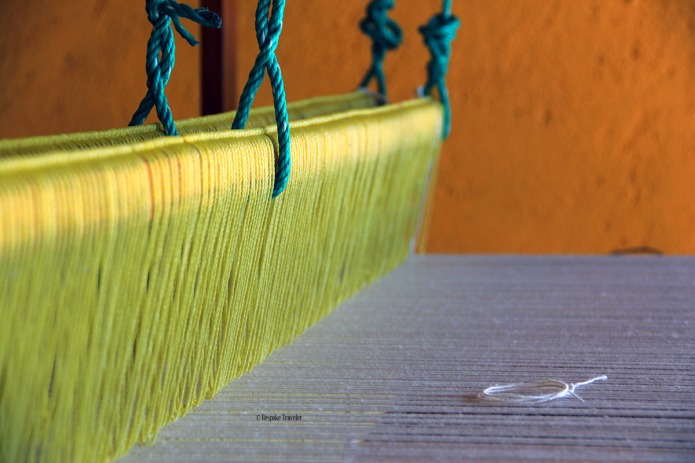 There were no signs here, no restaurants, no shops, and no Spanish spoken. A lone dog, its head on its paws, eyed me in boredom. “Down there is where the pumas live,” Daniel, my chaperone said, pointing to the dense rolling hills surrounding us. We advanced towards a barn house. Cacti carpeted the yard. An elder hunched over a loom outside the front door. Splays of butterfly yellow spooled out from his apparatus.
There were no signs here, no restaurants, no shops, and no Spanish spoken. A lone dog, its head on its paws, eyed me in boredom. “Down there is where the pumas live,” Daniel, my chaperone said, pointing to the dense rolling hills surrounding us. We advanced towards a barn house. Cacti carpeted the yard. An elder hunched over a loom outside the front door. Splays of butterfly yellow spooled out from his apparatus.
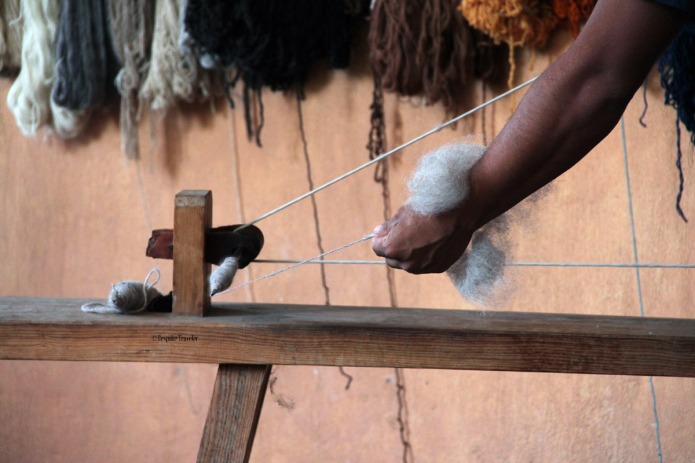
“You’ve found me,” a man in a navy embroidered shirt announced in English as he came out. He spoke to the weaver in a melodious and lilting tongue.
“Zapotec,” Daniel whispered. “It’s the only way to communicate with anyone in the village.” When they’d finished their conversation, Daniel introduced me. “Meet Nico, his family has been farming and weaving here for centuries.”
“Yes. Welcome to our workshop!” Nico replied, smiling. “Come inside. I will show you where the magic happens.” In the living space tapestries of indigo, mauve, and sepia riddled with geometric cyphers hung from the wall, draped over the dining table, and covered the floor.

For the next hour and a half Nico instructed us on local ingredients his parents use to dye the wool; “everything we grow here or get from our neighbors.” He showed us mixing and mordanting processes; “it all depends on timing.” He taught us traditional designs that convey meaning for his tribe; “the zig-zag represents lightning, the spiral is our life cycle.” Finally, he demonstrated how to operate the treadle loom. His fingers flew over the shuttles, darting between the curtain of yarn and the frame. His feet pedaled smoothly, so that both the heddles and the levers made a rhythmic beat as the carpet set into its pattern.
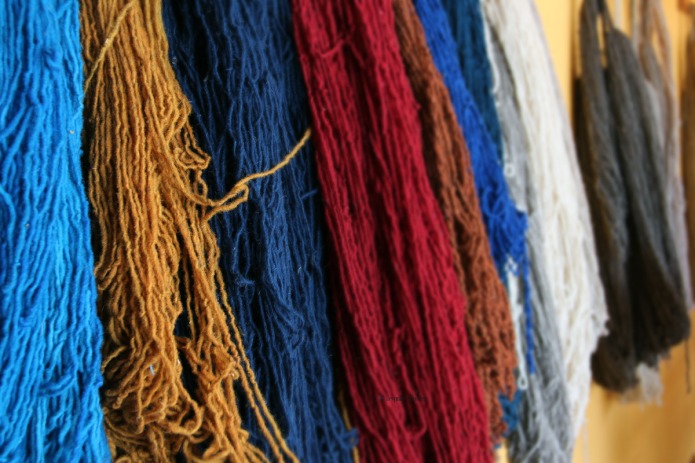
“When did you start learning to weave?” I enquired.
“At six years old.”
“Nico just decided to return to rug making, though,” Daniel explained. “He’s been overseas studying.”
“Oh! What were you studying?”
“I completed my master’s degree in textile engineering.”
“Before that, he graduated as a chemistry major. His parents hoped he’d join a tech start-up or go into academia.”
Nico laughed. “Yes, instead I’m disappointing them by carrying on the old traditions.”
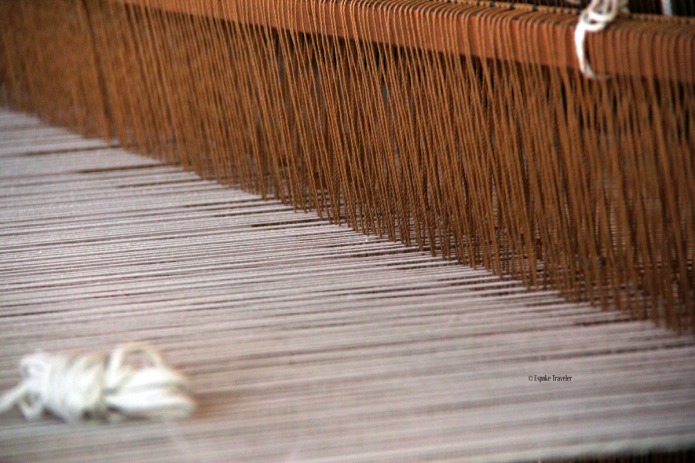
“What made you want to return home?” I asked.
“This is where I belong. I could have pursued those other careers, but they felt too small for me. I thought if I was going to give my life towards any profession, it should be one that called to me, something that was a part of who I was.”
“You don’t feel trapped? Worried about the prospects of your dying craft?” Daniel teased.
“That is always a concern. But I am hoping that by putting my education towards guiding my ancestor’s knowledge into the future, I can both keep their skill alive and infuse innovation into it.”
“You should see all the clever ideas he’s got to expand the business.”
“I’m not ready,” Nico replied, embarrassed, “there’s so much to be done and I’m still in the process of figuring out how best we should move forward.”
“Nico’s thinking of going beyond the conventional motifs, really bringing the design component into the future.”
“And what do your parents think about that?”
“They’re unsure of course. I’m trying to make them understand that implementing computer graphics and creating more complex sketches will get our artistry noticed. But, right now I’m excited about color play. I’m like a kid in the lab….” Nico scurried between his baskets of marigolds, tarragon, persimmon, moss, and cochineal animatedly handling the seeds, powders, and leaves. “I’m changing the water type I use…experimenting with oxidation levels…combining different acids and bases…researching different fibers as well.”
“Are you modernizing to aniline dyes?” Daniel asked.
Nico grinned. “No, no, no…I would never do that…it would be easier and faster, but where’s the fun?”

Like any creative endeavor weaving is an arduous craft. Very few of the villagers still practicing the art make a name for themselves. Since Nico employs only natural methods, each process is even more time consuming. Despite his uncertain future, it was refreshing to see Nico so enthusiastic, willing to forego the dependability of other occupations to commit to weaving. Perhaps it’s because I so often struggle to feel confident in my metier, but I admired Nico for his audacity and dedication.
“You’re seeing this through, then?”
“My dream is to have one of my designs displayed in an avant-garde museum, so that there’s a thread between the artistry of my forefathers and what lies ahead.”
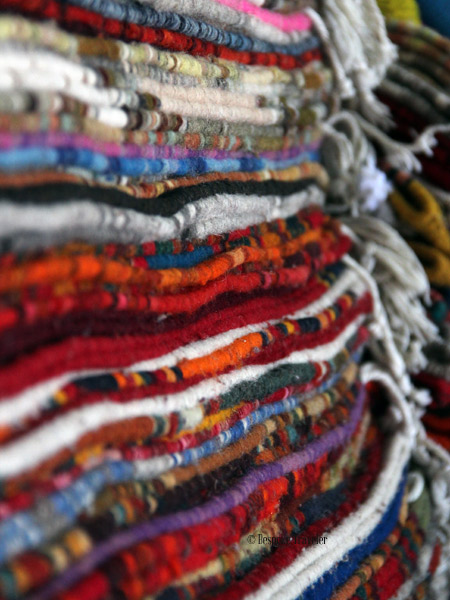
As we veered to the kitchen for lunch, I couldn’t stop ruminating about Nico’s vision. It’s difficult for the past to coexist with transformation. It either gets obliterated or mummified in arrested development. So, I’m eager to discover how Nico will honor the path of his ancestors while embracing our digital age. I hope he will be able to usher history forward as he seeks to weave the future into the past.
TRAVEL NOTE:
Most artisans live and work deep in Oaxaca valley and use middlemen to sell their wares in the markets. They continue to depend exclusively on tourism and face economic and social barriers. While visiting make sure to travel outside of Oaxaca City, into the region’s ethnic villages each of which specializes in a different craft such as pottery, textiles, wood carvings, and silversmithing.
Watching (and interacting with) local artisans is such a wonderful entry into discovering a culture. Let me know about crafts people you’ve encountered whose work has amazed you and feel free to add a link to their shops, or your own if you are a maker, in the comments below!
Discover more from Bespoke Traveler
Subscribe to get the latest posts to your email.





What a gift to have had the chance to talk with a craftsman who has been carrying on his family’s work for centuries. That doesn’t happen everyday, does it? I like that he’s interested in evolving, too. A must in today’s world.
It’s so nice to hear from you! You’re right, as most traditional crafts fade, it’s difficult to still find a younger generation invested in continuing the practices. Speaking with Nico — a person of vision — was indeed a privilege.
Nico is very impressive. Hope he is successful. Did you buy anything? The colors are gorgeous.
Yes, I bought a rug whose colors and pattern I fell in love with.
Heartwarming and inspiring. I have lot of respect and admiration for unsung heroes like Nico. May he find the right balance! The picture of marigolds took me back to the Flower Market.
Aren’t those flower and plant colors so beautiful? Of course as a natural artisan Nico will have to pursue his artistry in a sustainable manner. Thanks so much for stopping by.
Wow, I really love this post, and I have so much respect for Nico. Throwing practicality and pragmatism to the side and going full throttle for your dream and passion. It’s something I wish I could do–full-fledged devotion to a craft.
I hope he’s able to keep these traditions alive by melding them with the modern. I hope Nico makes it–sounds like he’s got a vision!
Thank you so much. I interact with so many inspiring people on my travels, it’s made me think differently about my own life as well. I wish you all the best in pursuing your own craft.
Fascinating, and beautiful colors. Just revisiting your blog after too long a delay. I hope we’ll see more from you in 2019.
That is so kind of you, thank you! Wishing you a most marvelous new year.
“My dream is to have one of my designs displayed in an avant-garde museum, so that there’s a thread between the artistry of my forefathers and what lies ahead.” That line right there, says it all.. Fascinating, I’m jealous (in a good way) of your adventures! Thank you for enlightening us!
I’ve been so privileged to have as many adventures as I have had! And I am very grateful for each of them. This particular interaction in the Oaxaca valley taught me to look at craft as art, just as meaningful and story-driven as anything I’ve seen in museums or galleries.
Must admit, I was taken aback when you said he had his master’s! Did not see that coming-another lesson in non-judgement. I met Mayan man this past week at our local Himalayan eatery, he was so fascinating and a voracious reader. The point is he came here for a “better life” but is longing too go back home. We wanted to join him, Manakshi& her husband and retire there. Life is slow there he says and he misses it… I’m longing to explore …
For some people home has a powerful call. I have very much come to appreciate how the artisanal life in central and South America has managed to survive so much and remains a vital part of modern society there.
Your stories are always so captivating. I’m glad that Nico honored his parents wishes and got a wonderful education but I’m also happy that he decided to follow what he loved. Hopefully he can carry on with the traditions and be successful.
Thank you Karen. It’s wonderful to meet someone who embraces the best of both the past and the future.
An incredible story – embracing tradition in an all-too-digital world!
Excellent post! I used to have a loom and weave. This post makes me wish I still did.
Thanks. I didn’t know you used to weave, that’s so wonderful! What made you stop?
There’s something magical about weaving. I’ve always wondered how those threads mix in the right sequence to make beautiful textures. It’s exquisite artistry and to think it’s been passed from one generation to another. Loved your pictures and they capture the essence of weaving perfectly. I do hope the artisans can adapt and preserve their tradition for the next generation.
You’re so right. Watching the weavers was magical, the way they seemed to be a part of the loom, the way their hands and feet moved in perfect coordination, they way they knew how to make the patter in their head come alive on the machine….
The dialogue and colorful visuals in this post transport me to Nico’s workshop. His work is masterful! May his dream come true.
He’ll be delighted to discover how many are rooting for him. Thanks for your words of support.
My gosh! Look at those colours! I have so much admiration for craftsmanship. In a time where everything is automated and mass produced – I have so much admiration for the art of creating! Did you buy any of his gorgeous creations?
Me too! I don’t have one of Nico’s creations, but I did purchase a more traditional one his father had made.
Good luck to Nico! He sounds like a man who could succeed. 🙂 🙂
Love the vibrant colours. I regret not getting to the Oaxaca region when I was in Mexico. Next time, hopefully.
It’s been wonderful to explore this region of Mexico and I’m looking forward to discovering other intriguing parts of the country as well.